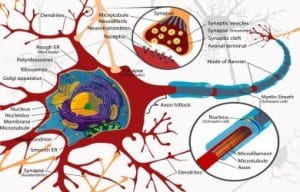Olfactory nerve:
- Purely Sensory
- Telencephalon Anterior olfactory nucleus
- Transmits the sense of smell.
- Located in olfactory foramina in the cribriform plate of ethmoid.
Optic nerve
- Purely Sensory
- Diencephalon Ganglion cells of retina.
- Transmits visual information to the brain.
- Located in the optic canal.
Oculomotor nerve
- Mainly Motor Anterior aspect of Midbrain
- Oculomotor nucleus, Edinger-Westphal nucleus
- Innervates the levator palpebrae superioris, superior rectus, medial rectus, inferior rectus, and inferior oblique, which collectively perform most eye movements.
- Also innervates the sphincter pupillae and the muscles of the ciliary body.
- Located in the superior orbital fissure.
Trochlear nerve
- Mainly Motor Dorsal aspect of Midbrain
- Trochlear nucleus
- Innervates the superior oblique muscle, which depresses, rotates laterally, and intorts the eyeball.
- Located in the superior orbital fissure.
Trigeminal nerve
- Both Sensory and Motor
- Pons: Principal sensory trigeminal nucleus, Spinal trigeminal nucleus, Mesencephalic trigeminal nucleus, Trigeminal motor nucleus
- Receives sensation from the face and innervates the muscles of mastication.
- Located in the superior orbital fissure (ophthalmic nerve – V1), foramen rotundum (maxillary nerve – V2), and foramen ovale (mandibular nerve – V3).
- Abducens nerve
- Mainly Motor
- Posterior margin of Pons
- Abducens nucleus
- Innervates the lateral rectus, which abducts the eye.
- Located in the superior orbital fissure.
Facial nerve
- Both Sensory and Motor
- Pons (cerebellopontine angle) above olive Facial nucleus, Solitary nucleus, Superior salivary nucleus
- Provides motor innervation to the muscles of facial expression, posterior belly of the digastric muscle, and stapedius muscle.
- Also receives the special sense of taste from the anterior 2/3 of the tongue and provides secretomotor innervation to the salivary glands (except parotid) and the lacrimal gland.
- Located in and runs through the internal acoustic canal to the facial canal and exits at the stylomastoid foramen.
Vestibulocochlear nerve (or auditory-vestibular nerve or statoacoustic nerve)
- Mostly sensory
- Lateral to CN VII (cerebellopontine angle) Vestibular nuclei, Cochlear nuclei Senses sound, rotation, and gravity (essential for balance and movement).
- More specifically, the vestibular branch carries impulses for equilibrium and the cochlear branch carries impulses for hearing.
- Located in the internal acoustic canal.
Glossopharyngeal nerve
- Both Sensory and Motor
- Medulla Nucleus ambiguus, Inferior salivary nucleus, Solitary nucleus
- Receives taste from the posterior 1/3 of the tongue, provides secretomotor innervation to the parotid gland, and provides motor innervation to the stylopharyngeus.
- Some sensation is also relayed to the brain from the palatine tonsils.
- Located in the jugular foramen.
Vagus nerve
- Both Sensory and Motor
- Posterolateral sulcus of Medulla Nucleus ambiguus, Dorsal motor vagal nucleus, Solitary nucleus
- Supplies branchiomotor innervation to most laryngeal and pharyngeal muscles (except the stylopharyngeus, which is innervated by the glossopharyngeal). Also provides parasympathetic fibers to nearly all thoracic and abdominal viscera down to the splenic flexure.
- Receives the special sense of taste from the epiglottis.
- A major function: controls muscles for voice and resonance and the soft palate.
- Symptoms of damage: dysphagia (swallowing problems), velopharyngeal insufficiency.
- Located in the jugular foramen.
11. Accessory nerve (or cranial accessory nerve or spinal accessory nerve)
- Mainly Motor
- Cranial and Spinal Roots Nucleus ambiguus,
- Spinal accessory nucleus Controls the sternocleidomastoid and trapezius muscles, and overlaps with functions of the vagus nerve (CN X).
- Symptoms of damage: inability to shrug, weak head movement.
- Located in the jugular foramen.
12. Hypoglossal nerve
- Mainly Motor
- Medulla Hypoglossal nucleus
- Provides motor innervation to the muscles of the tongue (except for the palatoglossus, which is innervated by the vagus nerve) and other glossal muscles.
- Important for swallowing (bolus formation) and speech articulation.
- Located in the hypoglossal canal.


The article may be more informative if you add the course of each cranial nerves.